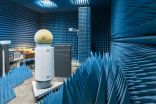Scientists create invisible objects without metamaterial cloaking
2015-04-14
(Press-News.org) Physicists from ITMO University, Ioffe Institute and Australian National University managed to make homogenous cylindrical objects completely invisible in the microwave range. Contrary to the now prevailing notion of invisibility that relies on metamaterial coatings, the scientists achieved the result using a homogenous object without any additional coating layers. The method is based on a new understanding of electromagnetic wave scattering. The results of the study were published in Scientific Reports.
The scientists studied light scattering from a glass cylinder filled with water. In essence, such an experiment represents a two-dimensional analog of a classical problem of scattering from a homogeneous sphere (Mie scattering), the solution to which is known for almost a century. However, this classical problem contains unusual physics that manifests itself when materials with high values of refractive index are involved. In the study, the scientists used ordinary water whose refractive index can be regulated by changing temperature.
As it turned out, high refractive index is associated with two scattering mechanisms: resonant scattering, which is related to the localization of light inside the cylinder, and non-resonant, which is characterized by smooth dependence on the wave frequency. The interaction between these mechanisms is referred to as Fano resonances. The researchers discovered that at certain frequencies waves scattered via resonant and non-resonant mechanisms have opposite phases and are mutually destroyed, thus making the object invisible.
The work led to the first experimental observation of an invisible homogeneous object by means of scattering cancellation. Importantly, the developed technique made it possible to switch from visibility to invisibility regimes at the same frequency of 1.9 GHz by simply changing the temperature of the water in the cylinder from 90 °C to 50 °C.
"Our theoretical calculations were successfully tested in microwave experiments. What matters is that the invisibility idea we implemented in our work can be applied to other electromagnetic wave ranges, including to the visible range. Materials with corresponding refractive index are either long known or can be developed at will," said Mikhail Rybin, first author of the paper and senior researcher at the Metamaterials Laboratory in ITMO University.
The discovery of invisibility phenomenon in a homogenous object and not an object covered with additional coating layers is also important from the engineering point of view. Because it is much easier to produce a homogeneous cylinder, the discovery could prompt further development of nanoantennas, wherein invisible structural elements could help reduce disturbances. For instance, invisible rods could be used as supports for a miniature antenna complex connecting two optical chips.
The subject of invisibility came into prominence with the development of metamaterials - artificially designed structures with optical properties that are not encountered elsewhere in nature. Metamaterials are capable of changing the direction of light in exotic ways, including making light curve around the cloaked object. Nevertheless, coating layers based on metamaterials are extremely hard to fabricate and are not compatible with many other invisibility ideas. The method developed by the group is based on a new understanding of scattering processes and leaves behind the existing ones in simplicity and cost-effectiveness.
INFORMATION:
[Attachments] See images for this press release:


ELSE PRESS RELEASES FROM THIS DATE:
2015-04-14
The number of children being diagnosed with type 1 diabetes is increasing 3-4% every year and more so in school-aged children. Treating the condition is complex and poor management can often lead to medical emergencies that result in hospitalisation, placing ever greater demands on health services.
To improve the efficiency of these services and reduce potentially unnecessary admissions, researchers wanted find out how often children with type 1 diabetes are admitted to hospital compared with children of the same age, gender and socioeconomic class, living in the same ...
2015-04-14
The amount of government money pumped into dementia and stroke research in the UK has risen significantly in recent years, but it is still way too low when compared with the economic and personal impact these conditions have, finds a study published in the online journal BMJ Open.
The researchers assessed central government and charity research expenditure in 2012 into the UK's leading causes of death and disability: cancer, coronary heart disease, dementia and stroke.
In 2012, all four conditions accounted for over half (55%) of all UK deaths and for 5.5 million disability ...
2015-04-14
Children with type 1diabetes run almost five times the risk of being admitted to hospital for any reason as their peers, finds research published in the online journal BMJ Open.
Pre-schoolers and those from disadvantaged backgrounds are most at risk, the findings indicate.
The number of new cases of childhood type 1 diabetes has been rising steadily by around 3-4% a year, the evidence shows, and the risk of death among those with the condition under the age of 30 is nine times that of the general public.
The researchers analysed the causes of hospital admission after ...
2015-04-14
A new type of technology that senses minute changes in the levels of particular compounds in exhaled breath, accurately identifies high risk changes which herald the development of stomach cancer, reveals research published online in the journal Gut.
The findings prompt the researchers to suggest that the technology--known as nanoarray analysis--could be used not only to test for the presence of stomach cancer, but also to monitor those at high risk of subsequently developing the disease.
Gastric cancer develops in a series of well-defined steps, but there's currently ...
2015-04-14
1. Task Force weighs evidence on diabetes screening
Researchers for the U.S. Preventive Services Task Force (USPSTF) have completed a systematic evidence review to inform an upcoming update of Task Force recommendations on screening asymptomatic, nonpregnant adults for type 2 diabetes. The review is published in Annals of Internal Medicine .
Approximately 21 million persons in the U.S. received a diabetes diagnosis in 2010 and an estimated 8 million cases went undiagnosed. Screening asymptomatic persons for diabetes may lead to earlier identification and earlier ...
2015-04-14
While a debate was raging between scientists and government regulators on how best to explain to patients the risks of participating in clinical research studies that compare standardized treatments, a team of bioethicists boldly went where no experts had gone before -- to the public.
What the respondents said surprised them: Keep it simple, but always ask permission, even when the research only involves gathering data from anonymized medical records.
"We didn't anticipate that people would want to grant permission for medical record searches, a research method that ...
2015-04-13
ANN ARBOR--Research led by the University of Michigan Life Sciences Institute has identified a gene critical to controlling the body's ability to create blood cells and immune cells from blood-forming stem cells--known as hematopoietic stem cells.
The findings, scheduled for online publication in the Journal of Clinical Investigation April 13, provide new insights into the underlying mechanics of how the body creates and maintains a healthy blood supply and immune system, both in normal conditions and in situations of stress--like the body experiences following a bone ...
2015-04-13
DALLAS, April 13, 2015--The American Heart Association (AHA) released new recommendations today to address gaps in common standards around comprehensive workplace wellness programs (CWWPs). The recommendations improve the design, measurement and recognition of CWWPs, and, if adopted by employers, could significantly impact efforts to improve the cardiovascular health of the American workforce.
An advisory panel of experts in population and workplace health, cardiology and preventive medicine conducted the review, which includes an extensive evaluation of workplace ...
2015-04-13
WASHINGTON, DC - A medicinal liquid form of marijuana may show promise as a treatment for children with severe epilepsy that is not responding to other treatments, according to a study released today that will be presented at the American Academy of Neurology's 67th Annual Meeting in Washington, DC, April 18 to 25, 2015.
The study involved 213 people, ranging from toddlers to adults, with a median age of 11 who had severe epilepsy that did not respond to other treatments. Participants had Dravet syndrome and Lennox-Gastaut syndrome, epilepsy types that can lead to intellectual ...
2015-04-13
Tropical Cyclone Solo was dissipating over the Southwestern Pacific Ocean when NASA's Aqua satellite passed overhead on April 13, 2015.
On April 11 Tropical Cyclone Solo spawned warnings in New Caledonia as it passed by. By April 12, the warnings were dropped and wind shear had taken its toll on the storm weakening it.
On April 12 at 0300 UTC (April 11 at 11 p.m. EDT), the Joint Typhoon Warning Center (JTWC) issued their final bulletin on Solo. At that time it was 116 nautical miles north of Noumea, New Caledonia near 20.2 south latitude and 165.7 east longitude. Solo ...
LAST 30 PRESS RELEASES:
[Press-News.org] Scientists create invisible objects without metamaterial cloaking


